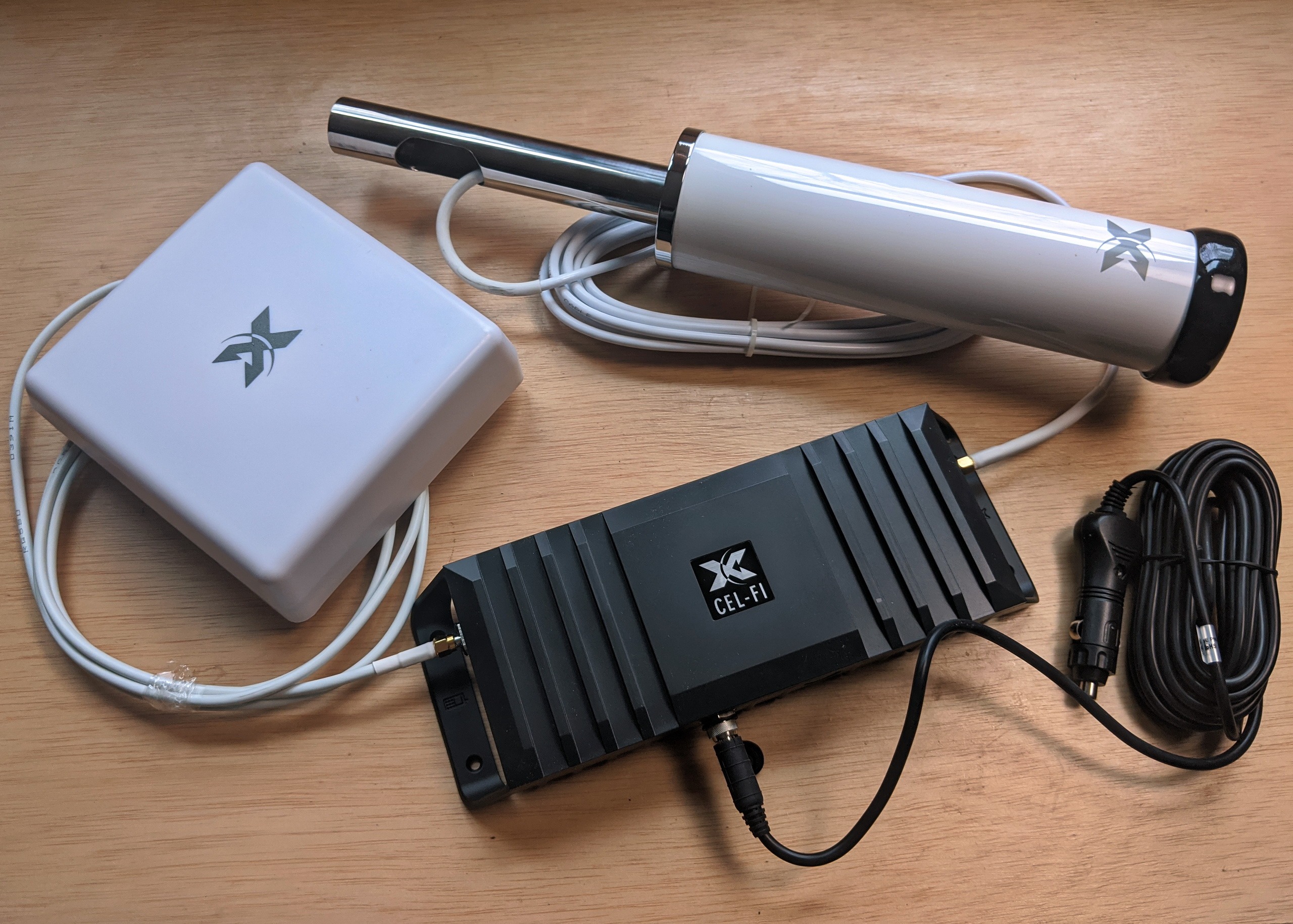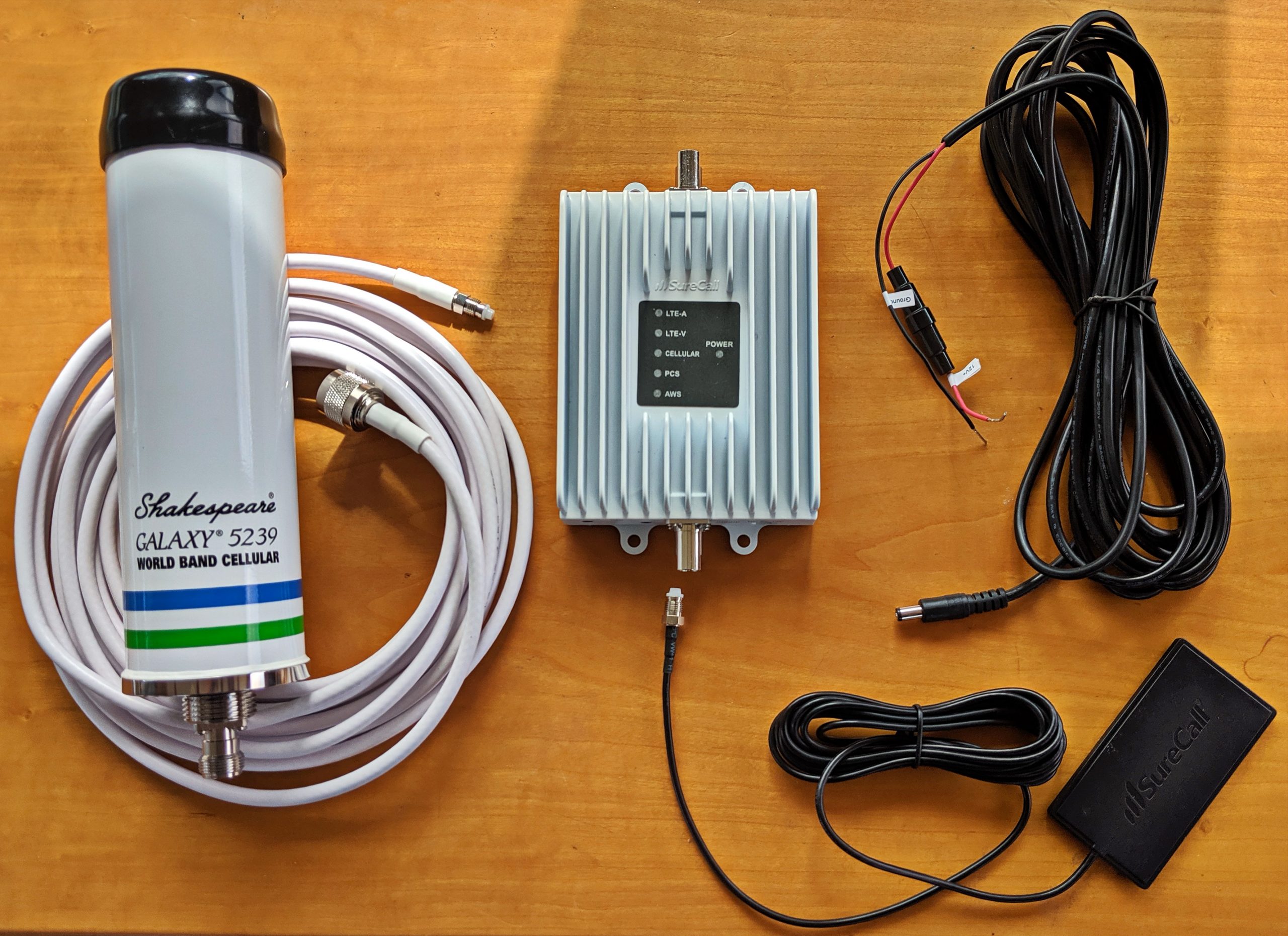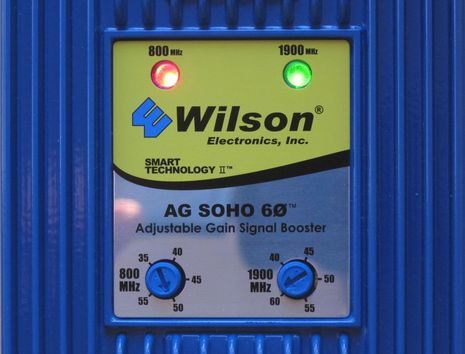SureCall Fusion2Go 2.0 cell booster, the testing begins
This is the selection of SureCall Fusion2Go cellular booster system components I’ll lug to the boat in North Carolina early Monday morning. The white outdoor antenna should mount fairly easily on Gizmo’s mast, the booster itself will tuck behind the lower helm with switchable 12v power, and I’ll put my phone on that indoor patch antenna when boosting is needed. In fact, I tried roughly that configuration in my basement shop yesterday, and the results were quite promising.
Note the signal strength graph in the Network Signal Info app running on my Google Pixel 2 XL Android phone. Without boost it was showing -113 dBm or about 7 of 15 bars, or 3 of 6 bars in the phone’s own less accurate and less responsive estimation. Sitting in exactly the same spot — and I saw this result several times — the powered up SureCall increased the signal to 13 bars (about -87 dBm) which looked like maximum signal on the phone itself.
In use on the boat, I expect this to mean that the phone will work better as a fast Verizon LTE WiFi hotspot in similar signal conditions, and should also be able to eek out some connectivity in marginal areas where the phone is otherwise nearly useless. I’m also confident that the SureCall Fusion2Go 2.0 will not get me in trouble for overpowering a cell tower (unlikely in a boat anyway), and will also let me know via red LEDs if the outdoor and indoor signals get mixed up (quite possible on many boats).
That’s because the FCC mandated automatic protections against these issues a few years ago and I don’t think that non-compliant cell boosters are available any longer (but watch out for eBay and similar). The regulatory change makes marine cell boosting easier, though getting the right parts kit can still be confusing.
Shown above is the complete contents of the SureCall Fusion2Go RV 2.0 kit loaned to me for testing by the good folks at the RepeaterStore {now called Waveform}. The low-power interior patch antenna is not shown as included, but I think that one comes in the box with every basic Fusion2Go. I will try the short RV-style whip interior antenna because then I could get boosting with the phone held to my ear, but I suspect that the relatively short distance to the exterior antenna with just a fiberglass cabin top in between will force me to use the patch antenna and my (fabulous Bose Hearphones) Bluetooth headset for boosted calls.
Meanwhile, I do wish that the SureCall outdoor antenna could adapt to a standard 1″-14 thread marine mount, but it does appear well made and I can use its base bolts with the flat mounting plates I added to Gizmo’s antenna farm. (Some boats may be able to use the aluminum L bracket, but those U bolts are not stainless.) Incidentally, the Fusion2Go User Guide (PDF) nicely lists all the antenna kitting options, including two for Marine use, and note that other antennas and cables can be substituted as long as the maximum dB gains are equivalent. I believe that means I can also try this booster with the excellent Digital Antenna Bullet and LMR 400 low-loss coax I once used successfully with a low-power Wilson car booster.
At any rate, a full review of the SureCall Fusion2Go cell booster will appear here eventually, and I’ll be testing lots of other gear as Gizmo slowly moves up the East Coast. Apologies in advance to TSA for all the gadgetry they may come across in my luggage on Monday.
















PS: There is a newer Fusion2go 3.0 model though I have yet to understand how it’s different than the 2.0 model:
https://www.repeaterstore.com/products/surecall-fusion2go-3-0-rv
I have spent a lot of time trying to connect to open WiFi hot spots using a WiFi extender with very little luck. Most times the sites are protected and occasionally the mooring or anchorage is too far to get a reliable signal even when I have the marina’s password.
Wouldn’t I be better off with an unlimited data plan from my cell phone carrier and use SureCall to make a robust connection? Can more than one cell phone use SureCall Fusion2Go? Another words, can I offer this to my crew without a lot of reconfiguration?
Hi Richard, Using my phone as a hotspot has often worked great for me, but do note that the “unlimited” plans have data caps after which the company may throttle data speed. But then again, my Verizon caps — one for phone, another for hotspot use — have gotten quite high and even when I have exceeded them, I did not see substantially lower performance.
And these days a booster is pretty optional if you stay in close. Coming down the coast last fall I hardly used one at all, just had the phone is a good spot with a power feed (hotspotting can kill a battery fast). With these modern boosters, more than one phone can work but that’s also dependent on the interior antenna you are able to use in your particular setup. On my boat without a lot of separation or signal insulation between outside and inside antennas, I tend to use the patch antenna which is only good for one phone.
I just finished testing a booster and various antennas over the last year plus – https://sailbits.com/best-lte-antenna-booster-boat/
I’m very interested to see how your testing goes. I have never liked SureCall’s antennas, but their boosters are great. And I especially like the app showing details on the signal – I have several myself, but that one is pretty nice looking.
There are a couple of new systems that came out in the last few months that are even better than the weBoost one I have, and likely the SureCall, but they are atrociously expensive. I’m hoping to get a hold of a couple of those for some testing this summer!
Ben, I just chatted with some friends who do testing of boosters and antennas all of the time, and they’ve said the SureCall 3.0 version is supposed to be more powerful than the 2.0, and even more powerful than the industry-leading weBoost 4G-X which has held that spot for several years. They just got the 3.0 and haven’t validated the claim, but it could be interesting to see the differences!
Thanks, Steve, though discouraging to learn that I may be testing an inferior model. Do your friends publish their testing results?
They do publish their results. I’m waiting to hear back if they have already gotten the 3.0 unit, or if it is delayed which often happens, and when they expect to be done reviewing it.
I’m the friend Steve is referring to here – we run the Mobile Internet Resource Center at http://www.MobileInternetInfo.com, and we blog about our personal RV and cruising adventures at Technomadia.com.
Here is our article on the new SureCall Fusion2Go 3.0, and a video with a few quick first impressions:
https://www.rvmobileinternet.com/new-cellular-boosters-from-surecall-fusion2go-3-0-fusiontrek/
SureCall has made some ambitious claims – we have a test unit, and will be taking a much closer look.
Bummer that you have the 2.0 to test – you should try to swap it out for the 3.0. I think the 2.0 is actually being discontinued once the inventory is cleared out.
Cheers,
– Chris
Note that the Shakespeare SuperHalo kits uses the same SureCall technology but the booster itself is marinized and the outside Galaxy antenna (which I’ve heard good things about) uses the standard marine 1” 14 thread mounting:
http://shakespeare-ce.com/marine/product/ca-vat-10-r-anywhere-superhalo-cellular-booster-kit/
Please mention the power consumption in your evaluation. I have stayed away from other amplifiers that consume so much power that can draw down the batteries when at anchor in remote locations.
Will do, Michael. I will note that the Fusion2Go 2 spec sheet reads “Power Consumption: ≤ 10W”, but boats on tight power budgets — like mine, though solar, LED lighting, and Firefly batteries have improved that situation a lot — should install a booster with switched 12v feed.
Even with ample power, you should always still install a booster to be easily switched off.
Most people do not realized it, but in many signal situations, a booster will actually slow data speeds down.
We go into the reasons why in this article here:
https://www.rvmobileinternet.com/resources/understanding-mimo-multiple-input-multiple-output-lte-speed-cell-booster-implications/
The bulk of the article is accessible only for members logged into our site, but I’d love to give you a complimentary membership for all you do. for the cruising community.
Drop me an email with the address I should set you up with.
Cheers!
– Chris
I’m ashamed that I have not written a follow up review yet, and I still have one task before I’ll feel right about it. At any rate, I have seen excellent automatic performance from this booster in many marginal Verizon cellular conditions. I was using the Digital Antenna Bullet antenna I already had installed on Gizmo along with LMR 400 cable — see https://panbo.com/wilson-weboost-4g-digital-bullet/ — but I hope to see similar when I finally install Surecall’s own bullet-like antenna. When it’s not 9 degrees cold outside.
I was reminded of the Surecall when I just came across this:
https://setsail.com/tech-talk-sure-call-gives-us-a-boost/
Ben, I went ahead and bought one of these units but did not have the need to install it because we had great service for most of the summer while on the Loop. In the Grafton, Illinois area, we were stopped for several days in an area with one bar of Verizon coverage. The only usable service was text messaging and that was slow. I hoisted the antenna to the top of our Grand Banks mast on a halyard and we enjoyed 3-4 bars of strength with pretty good data speed.
I look forward to your review.
Yes, still waiting for it 🙂
Sorry about that Geir, but I still haven’t tried the SureCall with the antenna shown in the kit photo at top. But it’s going to happen and I now also have a marine version of the same booster technology that will soon be introduced as the Shakespeare Stream. It looks good to me with the Fusion2GO marinized inside and a proper antenna that fits to a standard 1-inch marine mount.
In the meantime, you could check out this excellent review site:
https://www.rvmobileinternet.com/gear/mobile-cellular-boosters/